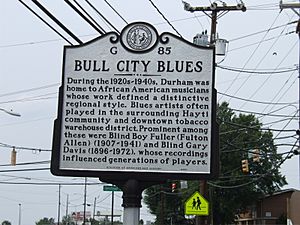Reverend Gary Davis facts for kids
Quick facts for kids
Reverend Gary Davis
|
|
|---|---|

in the 1960s
|
|
| Background information | |
| Birth name | Gary D. Davis |
| Also known as | Blind Gary Davis |
| Born | April 30, 1896 Laurens, South Carolina, United States |
| Died | May 5, 1972 (aged 76) Hammonton, New Jersey, United States |
| Genres | Gospel blues, Piedmont blues, country blues, folk blues |
| Instruments | Guitar, Banjo, vocals |
| Years active | 1930s–1970s |
Reverend Gary Davis, also known as Blind Gary Davis, was an amazing American musician. He was born on April 30, 1896, and passed away on May 5, 1972. He was a talented singer who played the banjo, guitar, and harmonica.
Gary Davis was born in Laurens, South Carolina. He became blind when he was a baby. In the 1930s, he started performing professionally in Durham, North Carolina. Later, he became a Christian minister. In the 1940s, he moved to New York. His career became very popular again during the American folk music revival in the 1960s. Some of his most famous songs are "Samson and Delilah" and "Death Don't Have No Mercy".
Gary Davis had a special way of playing the guitar called fingerpicking. This style influenced many other musicians. Some of his students included Stefan Grossman and David Bromberg. He also inspired famous artists like Bob Dylan, the Grateful Dead, and John Sebastian.
Contents
Early Life and Music
Gary Davis was born in Laurens, South Carolina, in the Piedmont area. He was one of only two children in his family who lived to be adults. He lost his eyesight when he was very young. Gary remembered that his mother did not treat him well. His father then had his grandmother take care of him. When Gary was 10 years old, his father died in Birmingham, Alabama. He was told his father was shot by the local sheriff.
He first sang in a Baptist church in South Carolina. He loved playing the guitar. He developed a unique style where he used only his thumb and index finger. He played gospel, ragtime, and blues songs. He also played traditional and his own tunes using four-part harmony.
In the mid-1920s, Davis moved to Durham, North Carolina. This city was a big center for black culture at that time. There, he taught Blind Boy Fuller how to play. He also worked with other musicians in the Piedmont blues scene, like Bull City Red.
In 1935, a store manager named J. B. Long helped Davis, Fuller, and Red. Long was known for supporting local artists. He introduced them to the American Record Company. Their first recording sessions helped start Davis's career. These early recordings are available on his album Complete Early Recordings.
Becoming a Minister
Gary Davis became a Christian and was ordained as a Baptist minister in Washington, North Carolina in 1933. After becoming a minister, he started to focus more on playing inspiring gospel music.
In the 1940s, the blues music scene in Durham began to slow down. So, Davis moved to New York. In 1951, he shared his life story with a folklorist named Elizabeth Lyttleton Harold. She wrote down their talks in a very long document.
Later Career and Influence
The folk music revival of the 1960s brought new energy to Davis's career. He performed at the Newport Folk Festival in 1965. Eleven songs from these performances were released on his 1967 album At Newport. In 1969, his former student, John Townley, convinced him to record his last studio album, O, Glory – The Apostolic Studio Sessions. This album was released after Davis passed away.
The famous folk group Peter, Paul and Mary recorded Gary Davis's version of "Samson and Delilah". This song was originally by Blind Willie Johnson, but Davis made it very popular. Even though the song was old, it was copyrighted as being written by Gary Davis when Peter, Paul and Mary recorded it. The money he earned from this song allowed Davis to buy a house. He often called it "the house that Peter, Paul and Mary built."
The band The Grateful Dead also covered "Samson and Delilah" on their album Terrapin Station. They gave credit to Davis for the song. They also covered his song "Death Don't Have No Mercy". The Blues Hall of Fame singer Darrell Mansfield has recorded several of Davis's songs too. The rock band The Rolling Stones gave credit to Davis for their song "You Gotta Move" on their 1971 album Sticky Fingers.
Gary Davis passed away from a heart attack in May 1972, in Hammonton, New Jersey. He is buried in Rockville Cemetery in Lynbrook, Long Island, New York.
Recordings
Reverend Gary Davis made many recordings throughout his life. Some of his albums were released after he died. His first LP, Blind Gary Davis – The Singing Reverend, came out in 1954. Other important albums include Harlem Street Singer (1960) and Say No to the Devil (1961). These recordings helped share his unique guitar playing and powerful voice with many people.
Posthumous Recognition
Reverend Gary Davis was honored along with Blind Boy Fuller in Durham, North Carolina, on November 2, 2019. This special recognition was given to them for their important contributions to Piedmont blues music.
See also
 In Spanish: Reverend Gary Davis para niños
In Spanish: Reverend Gary Davis para niños
- Gospel blues


